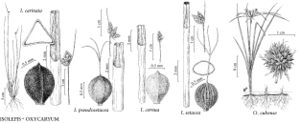familyCyperaceae
genusOxycaryum
Show Lower Taxa
Oxycaryum
in C. F. P. von Martius et al., Fl. Brasil. 2(1): 90. 1842.
Etymology: Greek oxys, sharp, and carya, nut
| Taxon | Illustrator ⠉ | |
|---|---|---|
 | Isolepis carinata Isolepis pseudosetacea Isolepis cernua Isolepis setacea Oxycaryum cubense | Amanda Humphrey Amanda Humphrey Amanda Humphrey Amanda Humphrey Amanda Humphrey |
Herbs, perennial, not cespitose, stoloniferous, aquatic. Culms solitary, trigonous. Leaves basal; ligules present, ciliate; blades flat to V-shaped in cross-section, prominently keeled on abaxial surface. Inflorescences terminal, umbellate heads or capitate; involucral-bracts 1–6+, spreading, leaflike. Spikelets: scales 5–10+, 3-ranked, spirally arranged, each subtending flower. Flowers bisexual; perianth absent; stamens 3; styles 2-fid, linear, base persistent. Achenes planoconvex, margins and apex corky.
Distribution
Tropical and subtropical America and Africa
Discussion
Species 1.
Selected References
None.
Lower Taxa
"shortened" is not a number.
... more about "Oxycaryum"
basifixed +
planoconvex +
persistent +
absent +
1;many +
2;3 +
trigonous +
Tropical and subtropical America and Africa +
basal +
abundant +
single +
bisexual +
umbellate +
capitate +
pseudoumbel +
modified +
spreading +
basal +
absent +
fused +
planoconvex +
falling +
absent +
with (1-)3-6(-30) bristles and/or scales +
thin +
2-3(-4)-carpellate +
fused +
pistillate +
subtending +
in C. F. P. von Martius et al., Fl. Brasil. +
1842 +
adventitious +
fibrous +
empty +
5;10 +
fertile +
2-keeled +
cylindric +
single +
distinct +
papillate +
undivided +
2-fid +
Oxycaryum +
Cyperaceae +
genus +
free +
thin +
stoloniferous +
perennial +
5;100 +